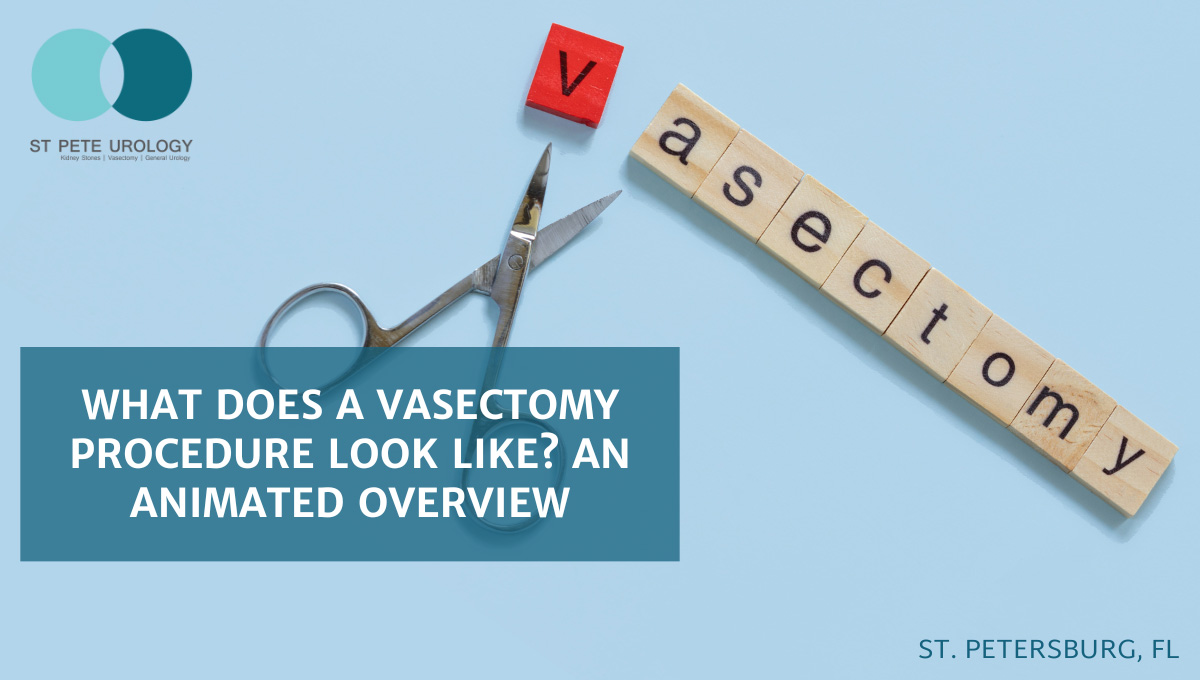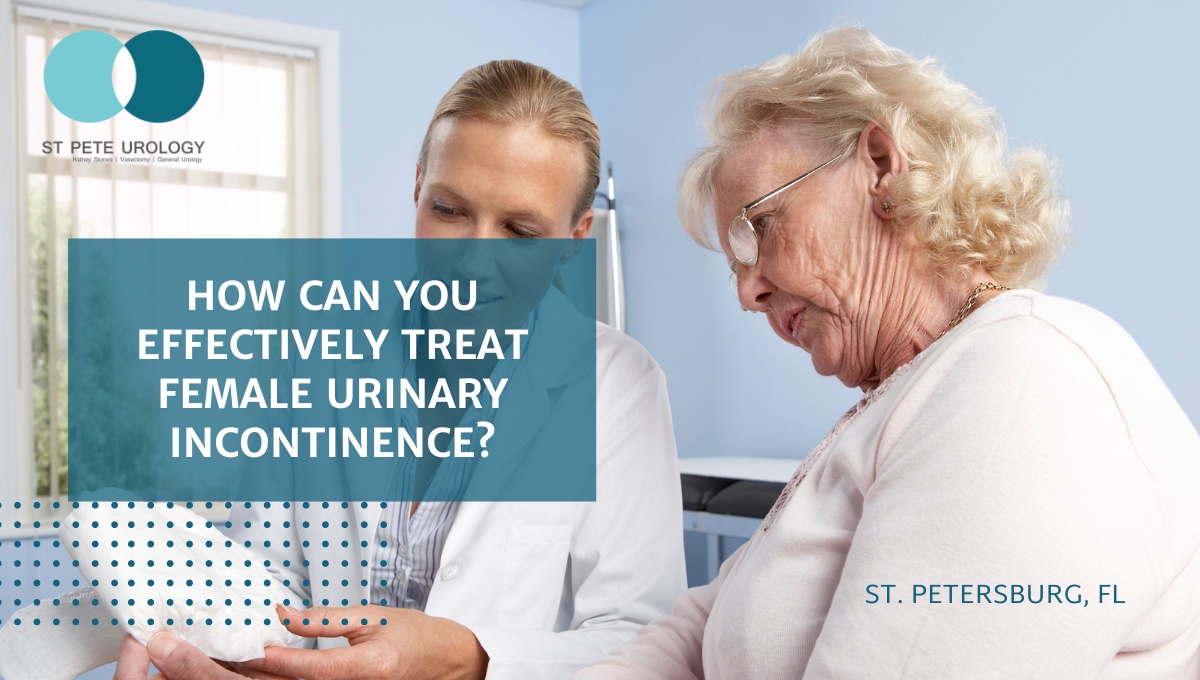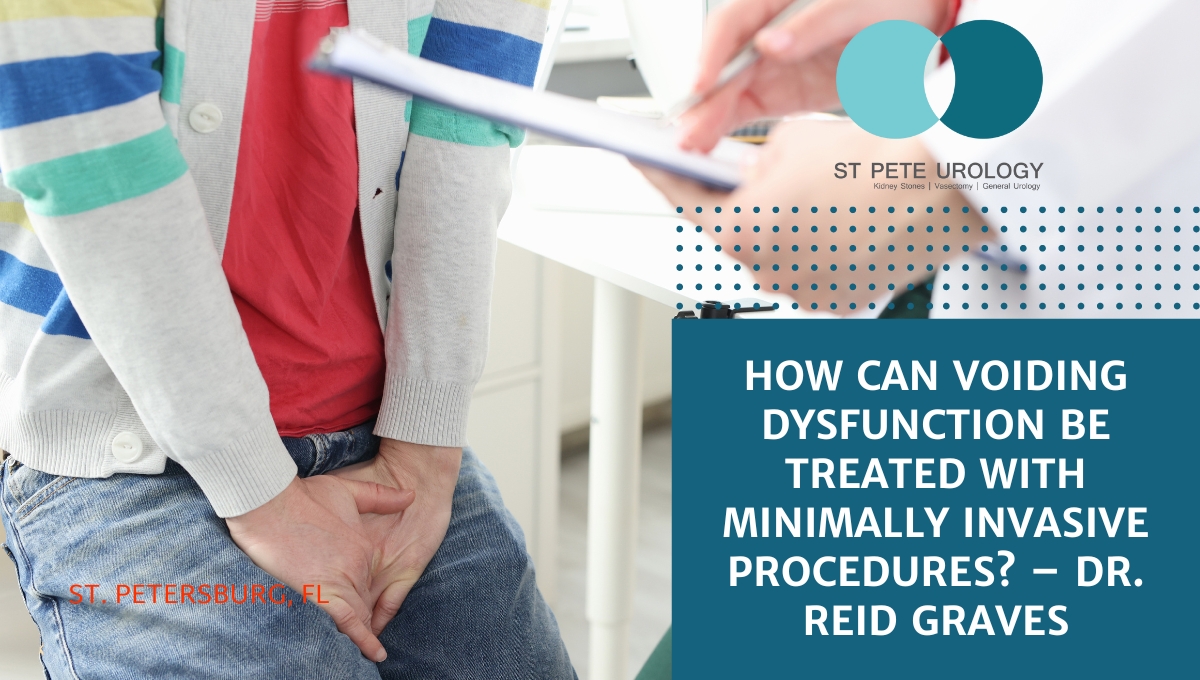Our urologists have an unrivaled understanding of the complexities of the vasectomy procedure. Watch our animated overview on vasectomy.
Continue readingAdvancements in Men’s BPH Treatment: UroLift Technology by Dr. Reid Graves
Key Takeaways:
- The UroLift technology is a minimally invasive device that staples the lobes of the prostate apart from each other, allowing for a much quicker recovery experience without a catheter.
- The UroLift technology is the only device that does not have the side effect of retrograde ejaculation, making it a viable treatment option for men grappling with BPH.
- St. Pete Urology is a leading urology practice offering state-of-the-art BPH treatment options, including the UroLift technology. Their commitment to delivering the best care to their patients makes them a trustworthy option for pursuing BPH treatment.
Navigating the path of finding the right BPH treatment can be a labyrinthine task. Over the years, advancements have been made in the field, but with each progress comes a new set of challenges. That’s where the UroLift technology steps in. It is a minimally invasive device yoking the future of urology with the demands of the contemporary patient. Spearheading this revolution in BPH treatment is Dr. Reid Graves, a board-certified urologist based in St. Petersburg, FL.
Embracing New Technologies
Dr. Graves, of St. Pete Urology, eloquently elucidates how the UroLift technology is adding a groundbreaking dimension to urology. He says, “There have been new technologies that have recently come out with a device called the UroLift technology, which essentially is a stapling device that staples the lobes of the prostate apart from each other so that the patient can void through their prostate.”
This advanced device, in Dr. Graves’ own words, “is an exciting new advancement in the era of BPH treatment for a couple of reasons.” It’s minimally invasive technology with almost no blood loss. Moreover, patients can even return home without a catheter, dramatically enhancing their recovery experience.
Addressing Troubling Side Effects
Technological triumph is praiseworthy. However, the true gauge of new treatments is its capacity to relieve the side effects that previously afflicted patients. One such side effect, often linked with BPH treatment, is retrograde ejaculation. This occurs when the ejaculate reverses into the bladder during orgasm. It prevents patients from seeing their ejaculate during intercourse, a predicament that disturbs many men.
Fortunately, in the case of the UroLift device, as Dr. Graves informs us, “This new treatment, the UroLift device, is the only device which does not have this side effect.” This revelation solidifies UroLift’s standing as a viable treatment option for men grappling with BPH.
A Brighter Future for BPH Treatment
The advent of UroLift technology highlights the fact that even in a field as intricate as urology, there is always room for innovation. By creating a less invasive treatment option, the field of urology has proven its commitment to patient wellbeing once more.
Looking ahead, it’s clear that UroLift technology is leading the charge in transforming the face of BPH treatment. From its efficacy to the lack of troubling side effects, the device has emerged as a promising solution to an enduring problem.
Trust St. Pete Urology for Top-Notch Treatment
St. Pete Urology, a leading urology practice in St. Petersburg, Florida, continues to be at the epicenter of these advancements, offering state-of-the-art BPH treatment options. These include the groundbreaking UroLift technology, a testament to their commitment to delivering the best care to their patients.
Through the skilled guidance of Dr. Reid Graves, St. Pete Urology is creating a better tomorrow, one patient at a time. So, trust St. Pete Urology to guide you through the web of decisions. Their understanding, expertise, and dedication to patient care set them apart from the rest. This ensures that you receive the most targeted and effective BPH treatment.
References:
- “UroLift Procedure for BPH (Enlarged Prostate) – Overview and Cost.” https://www.urologysanantonio.com/bph-enlarged-prostate/urolift-procedure.
- “Benign Prostatic Hyperplasia (BPH) – Urology Care Foundation.” https://www.urologyhealth.org/urology-a-z/b/benign-prostatic-hyperplasia-(bph).
- “Retrograde ejaculation – Symptoms and causes – Mayo Clinic.” 11 Jan. 2022, https://www.mayoclinic.org/diseases-conditions/retrograde-ejaculation/symptoms-causes/syc-20354890.
Transcription:
Hi, I’m Dr. Reid Graves and I’m a board certified urologist at St. Pete Urology. There have been new technologies that have recently come out with a device called the UroLift technology, which essentially is a stapling device that staples the lobes of the prostate apart from each other so that the patient can void through their prostate. Now this is an exciting new advancement in the era of BPH treatment for a couple of reasons. One, it is extremely minimally invasive with almost no blood loss and patients can even go home without a catheter.
In addition, one of the most troubling side effects for men with treatment of BPH is retrograde ejaculation. This is when the ejaculate goes backwards into the bladder when a patient is having an orgasm and they’re unable to see their ejaculate during intercourse. This is often something that bothers men and this new treatment, the UroLift device, is the only device which does not have this side effect. And so this is something that is a new exciting advancement in this field.
How Can a Prior Vasectomy Procedure Be Reversed with Vasectomy Reversal?
Key Takeaways:
- Men who have had a vasectomy can consider a vasectomy reversal procedure to restore fertility and have a chance of fathering a child again.
- A successful vasectomy reversal involves making small incisions in the scrotum to reconnect the vas deferens, and success rates can be improved by entrusting the reversal to a reputable urologist.
- Alternative options such as IVF remain viable if the vasectomy reversal is unsuccessful or not feasible.
First Steps: Determining Your Eligibility for Reversal
You may think it is impossible to start or expand your family after a vasectomy procedure. However, there is hope through a ground-breaking medical solution known as vasectomy reversal. Reid Graves, a reputable urologist at St. Pete Urology, asserts that men who have undergone vasectomy but now wish to have children again can consider this remarkable procedure. The need for a vasectomy reversal often arises when men form new relationships with partners who desire to have children. The cut vas deferens from the prior vasectomy renders them unable to conceive, creating this necessity.
Delving into the Procedure: How Vasectomy Reversal Works
Graves explains that, to achieve a successful vasectomy reversal, small incisions are made in the scrotum. These incisions bring the isolated ends of the vas deferens back together. Using advanced medical equipment such as a microscope or robotic technology, the urologist then meticulously sutures the vas deferens. This surgical intervention restores the natural pathway for sperm to travel from the testicles to the penis. Consequently, it allows the possibility of fathering a child once more.
Considering the Odds: The Success Rates
As with any medical procedure, there are no guarantees with vasectomy reversal. However, it is worth noting that the overall success rates are promising. A key determining factor of success lies in the expertise of the urologist performing the procedure, as well as their proficiency in utilizing advanced medical technology. By entrusting your reversal to a reputable urologist, you substantially increase your chances of welcoming a new addition to your family.
Weighing Your Options: The Benefits and Alternatives to Vasectomy Reversal
Beyond the possibility of fathering a child again, it offers the added benefit of minimal invasiveness. The small incisions made during the procedure are essential to reconnecting the vas deferens while reducing the risk of complications. In the event that your vasectomy reversal is unsuccessful or not feasible, assisted reproductive techniques such as in vitro fertilization (IVF) remain viable alternatives for having children.
Reclaiming Your Fertility at St Pete Urology
If you find yourself contemplating the possibility of a vasectomy reversal in St. Petersburg, FL, look no further than the experienced urologists at St Pete Urology. Dr. Reid Graves and his team of specialized professionals are dedicated to providing top-tier urological care and utilizing the latest advancements in medical technology for reversing your vasectomy.
Trust the experts at St. Pete Urology. They have built their reputation on ensuring that reversing your vasectomy is as seamless and successful as possible. Partner with a team that recognizes the deep-rooted desire to create or expand your family. They are eager to make it a reality for you. Schedule a consultation with St Pete Urology in St. Petersburg, FL, today. Take the first step toward reclaiming your fertility.
References:
- “What is the Success Rate for a Vasectomy Reversal?: Arizona Urology.” https://www.arizona-urology.com/blog/what-is-the-success-rate-for-a-vasectomy-reversal.
- “What is Assisted Reproductive Technology?.” https://www.cdc.gov/art/whatis.html.
- “Reversing Vasectomy Offers You Many Benefits.” https://www.bestvasectomy.com/benefits-of-vasectomy-reversal/.
Transcription:
My name is Reid Graves and I’m a urologist at St. Pete Urology. Sometimes men who have had vasectomies will meet a new partner that desires children and one of the complexities with this is since the vas deferens has been cut with the prior vasectomy they’re unable to have children. And when the patient’s partner wants a baby the only option is to try to reconnect these tubes back together. We can do that with what’s called a vasectomy reversal. In order to do this we have to make small incisions in the scrotum, explore the scrotum and then bring the little tiny vas deferens back out together and using a microscope or even with robotic technology we’re able to sew the vas deferens back together so that the sperm can then travel from the testicle back to the penis so that the person can have a child.
How Can You Effectively Treat Female Urinary Incontinence?
Key Takeaways:
- The mid-urethral sling procedure is a surgical solution to female urinary incontinence that is minimally invasive and has a high success rate.
- Benefits of the mid-urethral sling procedure include a quick recovery time and return to normal activities within two to four weeks.
- The experienced urologists at St Pete Urology in St Petersburg, Florida, are dedicated to helping patients address urinary incontinence and regain control of their lives.
Introduction
Urinary incontinence is a health concern that affects many women throughout their lives. It is a problem that can lead to a loss of self-esteem and can impact daily activities. However, there is hope for those who suffer from this condition. In this article, we will explore the mid-urethral sling procedure, a surgical solution to female urinary incontinence. As Dr. Adam Oppenheim, a urologist with St. Pete Urology, explains, “the mid-urethral sling is a procedure that we offer for stress urinary incontinence in females.”
Understanding Female Urinary Incontinence
Before delving into the mid-urethral sling procedure, it is essential to understand the underlying condition it addresses. Stress urinary incontinence occurs when pressure is placed on the bladder, causing unintentional leakage of urine. This can happen during everyday activities such as coughing, sneezing, laughing, or exercising. Additionally, it is often a result of weakened pelvic floor muscles, which can be caused by childbirth, obesity, or aging.
The Mid-Urethral Sling Procedure: A Solution for Stress Urinary Incontinence
For women who have bothersome stress urinary incontinence, a surgical procedure known as the mid-urethral sling is often the recommended treatment. This outpatient procedure takes under an hour to complete. Additionally, it shows promising results in addressing the issue of urinary incontinence. According to Dr. Oppenheim, “the patient is then sent home and follows up in the office within a few days.”
How Does the Mid-Urethral Sling Procedure Work?
The mid-urethral sling is a minimally invasive procedure that provides support to the urethra. A small incision is made in the vagina. Then, a synthetic mesh material is inserted to create a “sling” around the mid-portion of the urethra. This sling provides support to the weakened pelvic floor muscles. Furthermore, it helps prevent urine leakage during activities that put pressure on the bladder.
Benefits and Risks of the Mid-Urethral Sling Procedure
There are several benefits to the mid-urethral sling procedure, including:
1. The minimally invasive technique of the mid-urethral sling allows patients to return home the same day as the surgery since it’s an outpatient procedure. They typically have a follow-up appointment in just a few days.
2. The mid-urethral sling has demonstrated a high success rate in treating stress urinary incontinence, contributing significantly to many women regaining their quality of life.
3. The procedure boasts a relatively short recovery time, with most patients resuming normal activities within two to four weeks.
However, like any surgical procedure, the mid-urethral sling carries certain risks, which may encompass infection, bleeding, pain, or difficulties in urination. It’s crucial to discuss these potential risks and benefits with your urologist to determine if the mid-urethral sling procedure is the right choice for you.
Seek Help from Expert Urologists at St Pete Urology
If you are experiencing stress urinary incontinence, it is essential to know that there are effective treatments available, such as the mid-urethral sling procedure. The experienced urologists at St Pete Urology in St Petersburg, Florida, are dedicated to helping patients regain control of their lives by addressing urinary incontinence and providing exceptional care. Let the expert team at St Pete Urology help you take back your life and enjoy every moment without the worry of urinary incontinence.
References:
- “Midurethral Sling: What You Need to Know – Advanced Gynecology.” https://www.advancedgynecology.com/procedure/midurethral-sling/.
- “Treating urinary incontinence – mid-urethral sling operation.” https://www.thewomens.org.au/images/uploads/fact-sheets/Urinary-incontinence-Mid-Urethral-Sling.pdf.
- “Mid-Urethral Sling – Austin Urogynecology.” https://austinurogynecology.com/midurethral-sling/.
Transcription:
I’m Dr. Adam Oppenheim. I’m a urologist with St. Pete Urology. Generally, a surgical procedure known as a mid-urethral sling is offered for women who have bothersome stress urinary incontinence. So the mid-urethral sling is a procedure that we offer for stress urinary incontinence in females. It’s an outpatient procedure that takes usually less than an hour or so to complete. The patient is then sent home and follows up in the office within a few days.
What Are the Different Types of Prostate Problems? – Dr. Adam Oppenheim
Key Takeaways:
- There are two main types of prostate problems: Benign Prostatic Growth and Prostate Cancer.
- Early detection is key in managing and treating prostate cancer and should begin at age 50 (or 45 for those with a family history or higher risk factors).
- Treatment for both benign prostatic growth and prostate cancer depends on various factors and should be personalized to meet each patient’s unique needs.
Getting to Know Your Prostate
As the wise Dr. Adam Oppenheim says, “I’m a urologist with St. Pete Urology.” And who better to enlighten us on the different types of prostate problems than a seasoned professional? So, sit back and let’s delve into the world of prostate health.
First, let’s begin with some basics. The prostate is a walnut-sized gland located just below the bladder in men. Its primary function is to produce the fluid that nourishes and transports sperm. While this may seem like a small and insignificant part of the male anatomy, it can cause significant problems if not properly cared for.
Two Main Types of Prostate Problems
Dr. Oppenheim outlines two main issues in urology related to the prostate:
- Benign Prostatic Growth
- Prostate Cancer
Let’s take a closer look at each of these issues.
Benign Prostatic Growth: When Nature Takes Its Course
As Dr. Oppenheim explains, benign prostatic growth occurs when “patients have trouble urinating and they’re very bothered and often have to urinate very frequently or have a blocked stream.” This condition is known as Benign Prostatic Hyperplasia (BPH) and is a natural part of the aging process for men.
However, the symptoms of BPH can be quite bothersome, including:
- Frequent urination
- Difficulty starting and stopping urination
- Weak urine stream
- Dribbling of urine
While BPH is not life-threatening, it can significantly impact a man’s quality of life. Treatment options vary depending on the severity of symptoms and may include medications, minimally invasive procedures, or surgery.
Prostate Cancer: The Silent Threat
The second issue, prostate cancer, is a more sinister problem. Dr. Oppenheim informs us that “it doesn’t usually cause symptoms, but it can cause life-threatening cancer down the road if not treated.” This type of cancer occurs when malignant cells begin to grow uncontrollably in the prostate gland, often without any noticeable symptoms.
Early detection is key in managing and treating prostate cancer. Dr. Oppenheim suggests that men should begin screening for prostate cancer at age 50 (or 45 for those with a family history or higher risk factors). Regular screening tests, such as a prostate-specific antigen (PSA) blood test and digital rectal exam (DRE), can help identify any abnormalities in the prostate gland.
Choosing the Right Path: Customized Treatment Options for Prostate Problems
The course of treatment for both benign prostatic growth and prostate cancer depends on various factors, including the severity of the condition, age, overall health, and personal preferences. Dr. Oppenheim and the experts at St. Pete Urology offer personalized treatment plans designed to meet each patient’s unique needs.
For BPH, treatment options may include medication management, minimally invasive procedures, or surgery. For prostate cancer, treatment options can range from active surveillance (monitoring) to radiation or surgery, depending on the stage and aggressiveness of the cancer.
Conclusion: Trusting Your Prostate Health to St Pete Urology
Dr. Adam Oppenheim and the team at St Pete Urology in St Petersburg, Florida, understand the importance of early detection and customized treatment plans for men dealing with prostate problems. As Dr. Oppenheim says, “prostate health is a vital component of overall well-being, and we are here to help you navigate the complexities of this often-misunderstood aspect of men’s health.”
Don’t leave your prostate health to chance. Trust the urology professionals at St Pete Urology to provide the expertise and compassionate care you need. Schedule an appointment today and take control of your prostate health.
References:
- “Prostate disease – Better Health Channel.” https://www.betterhealth.vic.gov.au/health/conditionsandtreatments/prostate-disease.
- “Benign Prostatic Hyperplasia (BPH) – Urology Care Foundation.” https://www.urologyhealth.org/urology-a-z/b/benign-prostatic-hyperplasia-(bph).
- “Prostate Cancer: Types of Treatment.” https://www.cancer.net/cancer-types/prostate-cancer/types-treatment.
Transcription:
I’m Dr. Adam Oppenheim, I’m a urologist with St. Pete Urology.
So the prostate, there’s kind of two main issues in urology with the prostate.
There’s benign prostatic growth where patients have trouble urinating and they’re very bothered and often have to urinate very frequently or have a blocked stream.
And then there’s prostate cancer which is different and that doesn’t usually cause symptoms but it can cause life threatening cancer down the road if not treated.
How Does the Vasectomy Procedure Function? – Dr. Nicholas Laryngakis
Key Takeaways:
- The vasectomy procedure is relatively quick and painless and is performed by making a small incision in the scrotal skin and removing a small portion of the vas deferens.
- Post-surgery care involves avoiding heavy lifting or strenuous activity for the first 48 hours and avoiding ejaculation for 5 to 7 days.
- St. Pete Urology is dedicated to providing the highest quality of care for their patients, with a focus on patient education and transparent communication.
Demystifying the Vasectomy Procedure
For many men, the thought of undergoing a vasectomy can be both confusing and intimidating. However, gaining a better understanding of the procedure and its function can help ease those concerns. Dr. Nicholas Laryngakis is a board-certified urologist at St. Pete Urology. He provides an insight into the vasectomy procedure and what to expect during and after the surgery.
Quick and Painless: The Vasectomy Process
According to Dr. Laryngakis, “The vasectomy will take about 10 to 20 minutes to perform.” The process begins with the injection of a local anesthetic into the scrotal skin adjacent to the vas deferens. This step “affords almost immediate anesthesia,” ensuring patients remain comfortable and pain-free throughout the procedure.
After, a small incision is made in the scrotum. This incision allows the surgeon to expose the vas deferens. Next, a small portion of this tube is then removed, and the severed ends are either clipped, tied with suture, or cauterized. Typically, the incisions are closed with a single dissolvable suture. This generally heals within 7 to 10 days.
Post-Surgery Care and Precautions
After the surgery is complete, Dr. Laryngakis recommends that patients can “take showers the following morning after the procedure.” It’s essential to follow specific postoperative guidelines to ensure a smooth recovery process. Furthermore, reduces the risk of complications.
For the first 48 hours after the procedure, patients should avoid heavy lifting or strenuous activity. To ease any swelling, ice packs can be periodically applied to the scrotum during the first 24 to 36 hours. After, the patient may gradually begin physical activities as comfort allows.
In terms of resuming sexual activity, Dr. Laryngakis advises that “ejaculation should generally be avoided for about 5 to 7 days.”
Promoting Confidence and Trust: St. Pete Urology
At St. Pete Urology, the team of skilled professionals led by Dr. Nicholas Laryngakis is dedicated to providing the highest quality of care for their patients. With a focus on patient education and transparent communication. Furthermore, they help dispel concerns and fears surrounding urological procedures, such as vasectomy.
Located in St. Petersburg, Florida, St. Pete Urology offers a comprehensive range of services to address a variety of urological issues. Trust the experienced team at St. Pete Urology for a safe, comfortable, and effective vasectomy procedure. For more information or to schedule an appointment, visit their website or contact their office today.
References:
- “Recovering from a Vasectomy: What to Expect After You Get Snipped.” 26 Feb. 2020, https://www.iowaclinic.com/urology/recovering-from-vasectomy/.
- “Male Vasectomy Procedure | What is a … – Planned Parenthood.” https://www.plannedparenthood.org/learn/birth-control/vasectomy.
- “After Surgery Instructions for Vasectomy – Michigan Medicine.” https://www.med.umich.edu/1libr/urology/VasectomyPostOp.pdf.
How Can Voiding Dysfunction Be Treated with Minimally Invasive Procedures? – Dr. Reid Graves
Key Takeaways:
- Voiding dysfunction is a common problem among men which can cause frequent trips to the bathroom, difficulty emptying the bladder, and interrupted sleep.
- Minimally invasive procedures, such as green light laser surgery, can provide relief from voiding dysfunction with less blood loss, recovery time, and hospital stays.
- It is important to seek help from an experienced urologist when considering treatments for voiding dysfunction. St. Pete Urology in St. Petersburg, FL is committed to providing quality care to those struggling with this issue.
Introduction: A Common Problem Faced by Many Men
You’re not alone if you’re struggling with voiding dysfunction. It is one of the most common complaints that men have when they seek the help of a urologist. Dr. Reid Graves, a board-certified urologist, practices at St. Pete Urology in St. Petersburg, FL. He is here to assist individuals grappling with this frustrating issue. Let’s explore how minimally invasive procedures can provide relief and improve your quality of life.
Understanding Voiding Dysfunction
Voiding dysfunction can impact men’s lives in various ways, such as frequent and urgent trips to the bathroom, difficulty emptying the bladder, and interrupted sleep. This condition occurs when there’s a problem with the connection between the bladder and the urethra. It’s often caused by an enlarged prostate. This creates challenges as men attempt to urinate, leading to a range of unpleasant symptoms. Dr. Graves emphasizes the importance of finding an effective treatment, stating, “There are many options for treatment in this often difficult area.”
The Wonders of Minimally Invasive Procedures
In the past, treatment options for voiding dysfunction often involved more invasive surgeries. Now, advanced technology has made minimally invasive procedures a reality. These options significantly reduce blood loss, recovery time, and hospital stays. Dr. Graves mentions one popular minimally invasive treatment, saying, “Some of the things patients might have heard of are minimally invasive laser procedures such as the green light laser surgery of the prostate.” He goes on to explain how this innovative procedure compares to the traditional TURP method. In the traditional approach, the inside part of the prostate is removed. This is to improve the connection between the bladder and the urethra.
Green Light Laser Surgery – A Game Changer
Green light laser surgery has revolutionized the way urologists treat voiding dysfunction. This minimally invasive procedure works by removing the obstructing prostate tissue with a laser, allowing for improved urinary flow. Dr. Graves highlights the benefits of this procedure, saying, “The laser allows less blood loss and less hospital stay, and often patients go home the same day.” The reduced recovery time and minimal discomfort make it a preferred option for many men dealing with voiding dysfunction.
Finding the Right Urologist for You
It’s crucial to choose a urologist who has extensive experience and training in treating voiding dysfunction, especially when considering minimally invasive procedures. Dr. Graves assures that at St. Pete Urology, they have had “extensive comprehensive urologic training and it’s one of the best urology programs in the country.” Trusting your care to a skilled and knowledgeable urologist is the first step toward finding relief from voiding dysfunction.
Don’t Suffer in Silence – Seek Help From St. Pete Urology
Voiding dysfunction doesn’t have to control your life. With the innovative and minimally invasive procedures available at St. Pete Urology in St. Petersburg, FL, you can get back to enjoying your daily activities without constant worry about your urinary health. Don’t hesitate to reach out to the experienced urologists at St. Pete Urology, where they’re committed to helping you find the relief you deserve.
References:
- “Voiding Dysfunction – Urology – UCLA Health.” https://www.uclahealth.org/medical-services/urology/conditions-treated/adult-conditions/voiding-dysfunction.
- “BPH Laser Therapy With Greenlight | Laser for Enlarged Prostate.” https://www.treatmybph.com/bph-patient-us/treatment-options/laser-therapy-with-greenlight.html.
- “Voiding Dysfunction – Treatment Options – New York.” https://my.clevelandclinic.org/health/diseases/16394-non-neurogenic-voiding-dysfunction.
Transcription:
Hi, I’m Dr. Reid Graves and I’m a board certified urologist at St. Pete Urology.
One of the most common presenting complaints of men that present to a urology office is voiding dysfunction and trouble with urination. There are many options for treatment in this often difficult area for men to deal with and some of these are maximally invasive and but many of the options we have are minimally invasive.
Some of the things patients might have heard of are minimally invasive laser procedures such as the green light laser surgery of the prostate which is similar to what often people have heard of which is called a TURP where the inside part of the prostate is removed so that patients can void through their prostate which connects between the bladder and the urethra. The laser allows less blood loss and less hospital stay and often patients go home the same day. We had extensive comprehensive urologic training and it’s one of the best urology programs in the country.
Common Bladder Control Problems
Tonight we’re going to talk about bowel and bladder control primarily. So Dr. Graves and I both actually trained together at the University of Pennsylvania in Philadelphia and we’ve been each practicing for close to 10 years. And we’ve had five years of urology training in residency and med school before that.
And the topic tonight is something that we do have a lot of focus in and enjoy taking care of and have specialty in. All right so there’s three kind of categories to kind of simplify this about bladder control issues. One is stress incontinence and I’ll describe that more in the next slides. The second is urinary retention which is the inability to actually get urine out where the urine is trapped in the bladder and you can’t fully empty the bladder and the third is overactive bladder.
So stress incontinence is the kind of incontinence that some patients can have in which when you increase the pressure on the bladder it overcomes the ability of the sphincter to control the urine. So sneezing, coughing, laughing, standing up real quick after you’ve been sitting for a while, climbing up things like stairs, exercising and then you get a dribble or even sometimes a full emptying of the bladder as you do those activities so that’s deemed stress incontinence. And that is an issue typically with the sphincter itself and the pelvic floor with the inability to control the bladder from emptying. And that’s an issue that some women have with age or after childbirth that can occur. In regards to men that would be something that sometimes we see after prostate type procedures and then also you know something with the age that can occur. In regards to urinary retention that’s when you can’t fully empty your bladder. Sometimes patients will show up with to the emergency room or our office with the inability to empty their bladder and they need a catheter put in to drain the bladder. Other times it could be a slow chronic situation where they don’t empty the bladder fully and it builds up into a inability to empty. That’s actually dangerous because you’re not able to clear all the toxins out of your body and you can get infections or kidney failure, this is something that’s important to tease out. Usually in these cases you can have leaking but the main symptom is difficulty emptying and a weak stream. And then overactive bladder is is a quite common situation in which you have a bladder that isn’t able to hold urine for the amount of time it should in between urination. So you get frequent trips to the bathroom with strong urges to pee even though you just urinated, went to the bathroom and peed you know 20 minutes 30 minutes later you feel like you got to go again and are heading back to the bathroom. And that can sometimes progress into urge incontinence which is a type of leaking of urine as opposed to the stress incontinence where you sneeze cough strain and leak this is where you get a strong urge to pee and you can’t hold it back and then you end up having a leak before you make it to the bathroom in time.
And then a different kind of incontinence would be this fecal incontinence which is basically bowel incontinence and this is not urinary incontinence but a situation in which you have control issues with having bowel movements. So you can actually have loss of control where you have accidents with your stool sometimes that could be this like a strong urge that you cannot control or other times it’s a loss of feeling that you have to go and you can have either small accidents or a full incontinent episode with fecal incontinence
What Can Cause Incontinence
Tonight we’re going to talk about bowel and bladder control primarily. So Dr. Graves and I both actually trained together at the university of Pennsylvania in Philadelphia. And we’ve been each practicing for close to 10 years and we’ve had five years of urology training in residency and med school before that. And the topic tonight is something that we do have a lot of focus in and enjoy taking care of and have specialty in. So what causes incontinence of urine or stool there’s a huge host of things that something your doctor can figure out but sometimes it could be something you know is simple. If it’s mild like what you’re eating an excess amount of caffeine it can do that. Some people will be drinking an excessive amount of coffee, you know, I talk to some patients they’re drinking a pot of coffee a day. Other times it really has nothing to do with their diet, medications can do that certain diuretics can predispose to issues with urinary control. If you’re not as physically fit bedridden have other physical mobility issues sometimes that can deal with causing incontinence. And then other things can increase your risk like radiation of the pelvis before a prior injury to the spinal cord or your pelvic floor, certain pregnancy issues or childbirth like such as vaginal deliveries sometimes can have something to do with that. Complicated in terms of regards to different causes but something that is often easy to figure out when you see a physician.
How Does Bladder Bowel Control Work
Tonight we’re going to talk about bowel and bladder control primarily, so Dr. Graves and I both actually trained together at the University of Pennsylvania in Philadelphia. And we’ve been each practicing for close to ten years and we’ve had five years of urology training in residency and med school before that. And the topic tonight is something that we do have a lot of focus in and enjoy taking care of and have specialty in.
So bladder control is something we’ll discuss about the pathophysiology and how that works. So your kidneys filter your blood and make urine and then it goes into the bladder where it’s stored and then you pee that out. And you’re supposed to be able to control that and the bladder’s in muscle. And when the bladder gets full basically it’ll send a signal and you’ll get relaxation of the external sphincter, which is a sphincter control to control the urine. And then allow the sphincter to open and then the bladder squeezes down and drains the bladder. But this is a complex system and it does require basically the brain and its ability to inhibit the need to urinate and the ability to control relaxation. The sphincter and the spinal cord so it’s a pretty exquisite and very detailed system, but it’s something that different areas of that process can have an issue that could be fixed or could be the cause of the incumbents. And then the bowel control is very similar instead of a bladder you have intestines and a colon and a rectum where a stool is stored. And there is a sphincter as well that controls your ability to hold the stool in place and again that involves the brain the spinal cord and the the muscle of the rectum and the colon involved for bowel control you










